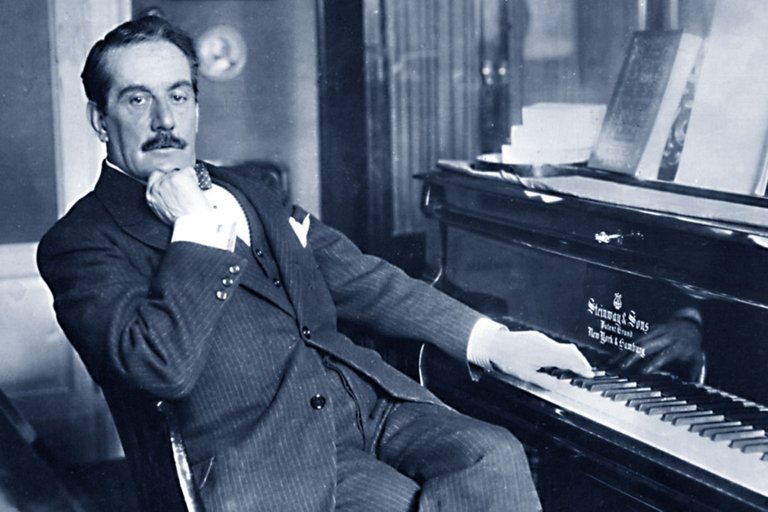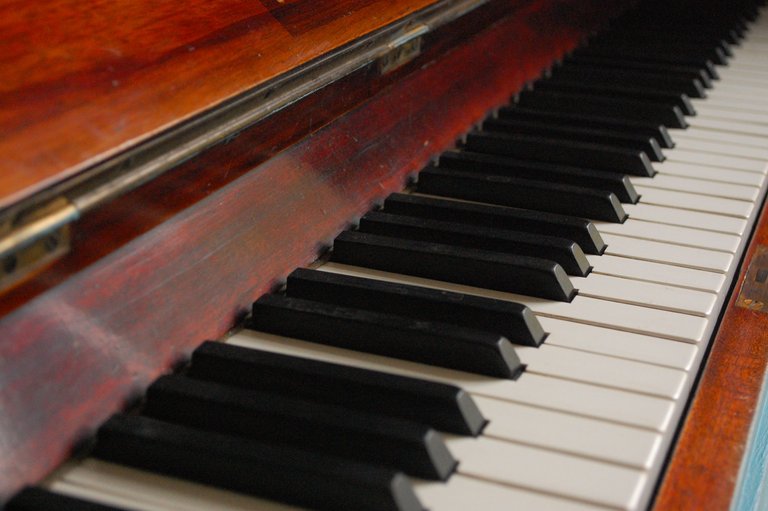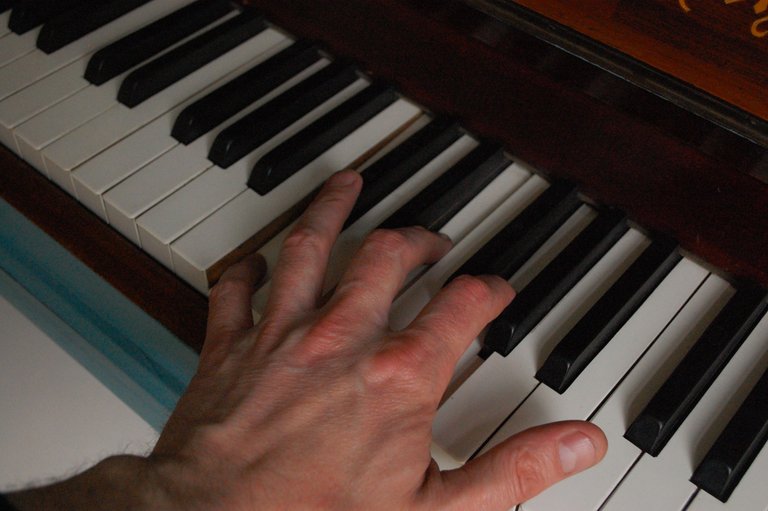The Two Fundamental Touches
Pianoforte passages may be divided broadly into two main types.
Chords, intervals, and isolated or detached single notes.
Connected or legato single notes.
The main difference between these types, as far as technique is concerned, is that the playing of the former necessitates some form of arm movements, whilst the playing of the latter demands finger movements. Let us examine this point in greater detail, as the distinction is important.
Supposing we wish to play a chord. It is quite clear that the one way we should not play it would be by placing our hands and fingers over the keyboard and making isolated upward and downward finger movements from the knuckle joints, keeping the hand and arm stationary.
We should make a movement of the hand at the wrist joint.
A movement of the forearm at the elbow joint.
Or a movement of the whole arm at the shoulder.
To make isolated finger movements would not only be extremely difficult, but probably entirely ineffective.
On the other hand, a series of connected single notes (such as a portion of a scale) seems quite naturally to demand the independent movements of one finger after another, such movements taking place from the knuckle joints. .
Thus we see that in pianoforte music one main type of passage demands arm movements of some kind, and the other type demands finger movements.
It is most essential that this distinction should be realised as a conscious mental process.
We shall commence our study of technique by considering the most effective means of playing passages of the first type-namely, chords, intervals, and isolated or detached single notes.
Arm Touch before Finger Touch.
In the past it was usual for a student to commence his technical studies with some form of five-finger exercise, but a little thought will show that this is not the best means towards the end.
In the first place, it is obvious that in learning anything, it is wise to begin with the easy and work towards the difficult.
Now, we are in general much more accustomed to making arm movements than individual and isolated movements of our fingers.
We have, in fact, from our earliest days been learning some degree of control of our arm movements, whereas in no single occupation in life, other than the playing of a musical instrument, are isolated finger movements required.
One might almost go so far as to say that the use of the fingers in pianoforte technique is one of the most difficult of all physiological co-ordinations.
The arrangements and plan of the finger muscles indicate clearly that nature does not really intend us to use our fingers separately, but, on the contrary, in groups for the one essential-to-life purpose, namely, for the act of grasping.
For this action we have a definitely inherited instinct, but the finger technique used in piano playing is an entirely artificial habit, for which we have in general no hereditary aptitude.
Secondly, the finger movements necessary for finger technique are controlled by extremely complex muscular processes, and there is ample scope for many undesirable muscular coordinations, which, if they do occur, render technique of this kind more difficult than it actually need be.
The student who attempts finger technique without knowing exactly what is the best way of setting about it, is almost certain to use not only his fingers, but also his arms, quite wrongly, and may continue indefinitely struggling against himself .
This process involves not only a tragic waste of time, but may also in many cases cause definite harm to the muscular system in the shape of neuritis, pianist’s cramp, and other ailments.
Arm movements, however, belong to quite a different category.
The muscular processes which control them are decidedly less complicated. 
Everything is in favour of commencing the study of pianoforte technique with arm movements, and not with finger movements.
Moreover, it is not sufficiently realised that whilst effective arm movements have little connection with the state or condition of the fingers, effective finger movements are definitely linked up with certain specific states or conditions of the arm.
We could, for example, make perfectly controlled and effective arm movements without bothering in the slightest degree about our fingers, but we cannot make effective or controlled finger movements without managing our arms correctly.
It should now be realised that we are able to make many different kinds of arm movements.
We can, for example, move our arm forwards, backwards, sideways, upwards, and downwards.
We can also rotate it at the shoulder joint ; in fact, we can make it move in any plane we wish.
Our next consideration will therefore be to decide which is the most effective of these many possible arm movements for the object we have in View.
The piano keys move upwards and downwards, it has been the habit to assume that the most efficient movements which the human body can make for the purpose of moving the keys down, are movements which are themselves directly downwards.
These are not the movements which give the player the greatest possibility of control.
1. Use your arm forwards and backwards (do not use your arm upwards and downwards.)
2. Play all chords, intervals and single notes, by pushing forwards and downwards with a push of the whole arm, keeping the movement as flat as possible.
Actually, what happens is that the upper arm is moved forward and the forearm simultaneously moved slightly downwards.
The movement is best conceived as a definite push, and its main scope forwards and backwards, not upwards and downwards.
(I) This one touch (“ Whole-arm push ”) can take the place of all the older whole-arm, forearm, and hand (wrist) touches,
(2) Physically it is easier to use the arm in this way, than to move it upwards and downwards.
(3) This touch gives a greater measure of tone control and produces a wider range of tonal intensities.
(4) When mastered, there remains only finger touch to be acquired, and thus a complete technique can be obtained by means of two touches. One arm touch and one finger touch.
It is possible to obtain by one touch, and one only, all those effects which have not been obtainable only by employing at least three touches (whole-arm, forearm, and hand).
By this one touch you can, and should, play the great majority of chord and interval passages (together with staccato single note passages) whether lento or prestissimo, whether pianissimo or fortissimo.
There is only one other main type of pianoforte passage, and that is the legato “ scale-arpeggio ” type, which obviously requires a finger touch.
Therefore the technique is obtainable by two touches.
One arm touch, and one finger touch.
The more simple we can make the learning of technique, the quicker and better shall we learn it.
This system being described is so simple that it enables you to think out for yourself which movements (arm or finger) should be used.
This the foundation of the technique.


Great article, although it is hard to describe techniques using only words! If you post with the #classical-music tag, it will be easier for us to find and support your classical music posts!
Your post has been supported and upvoted from the Classical Music community on Steemit as it appears to be of interest to our community. You can find details about us below.
Discord.
Follow our curation trail (classical-radio) at SteemAuto
The classical music community at #classical-music and Follow our community accounts @classical-music and @classical-radio.
You received an upvote from @MusicVoter due to the musical content of this post.
To find out how I decide who to up vote please READ THIS
Do you want to EARN CURATION REWARDS AUTOMATICALLY and help independent musicians?
HERE'S HOW
Atom Collector Records family@MusicVoter is part of the
Add dsound tracks and DTube & YouTube videos, get more fans and earn $INDIE!
Congratulations @stugalaxy! You have completed some achievement on Steemit and have been rewarded with new badge(s) :
Click on any badge to view your own Board of Honor on SteemitBoard.
For more information about SteemitBoard, click here
If you no longer want to receive notifications, reply to this comment with the word
STOPhey @stugalaxy I really love to listen piano but don't know how to play. your tutorial are great knowledge about piano